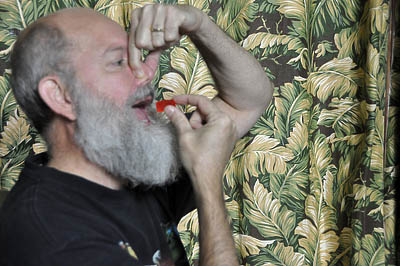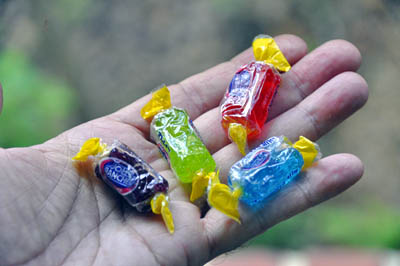
This time, we are going to take a look at a classic science experiment that has been used for a LONG time. In fact, it was already an old classic when I was a kid, and that was quite a while ago.
The experiment involves the link between our senses of taste and smell. Often it is done with apples and potatoes, but there is enough textural difference that you can often tell which is which. I have found that the results are much stronger with flavored candy. To try this, you will need:
- candy that has the same shape and texture, but comes in different flavors.

OK, lets begin with the standard experiment. Be sure that your pieces of candy will all feel the same in your mouth, and that they have distinctive flavors. If you don't see the candy, the taste should be your only clue to what flavor it is.
If you have a friend to help, then close your eyes, hold your nose, and have her give you one of the pieces of candy. Keeping eyes and nose tightly closed, put the candy in your mouth. You will taste a sweet taste, and probably some sour too, but you may be surprised that you can't tell if the candy is cherry, lime, orange, or some other flavor.
Then move your hand away from your nose, so you can breath normally. Yum! You get a sudden burst of flavor, telling you exactly what kind of candy it is. The reason for this is that your tongue has flavor receptors for basic flavors, such as sweet, salty, sour, bitter, and umami (the savory taste of meat.) Most of the other flavors that you taste are tied in with your sense of smell. If you can't smell them, then you don't taste them. That is why food tastes so bland when you have a cold.
But wait a minute! Your parents probably taught you to chew with your mouth closed. How can the smell get out of your mouth to go up your nose, so you can smell it? And your mouth stayed closed when you released your nose, but you still got that sudden burst of flavor. What is really happening?
Well, the smell of the food does have to reach your nose for you to taste all of those subtle flavors, but there is another path that those smells can take. Instead of inhaling those smells through your nose, you are exhaling them. As you breath out through your nose, your breath carries the smells from your mouth into your nose. You were not holding your nose to prevent you from inhaling the smells. Instead, you were blocking the way, so you could not exhale the smells through your nose.
Now that you are tasting the flavor, hold your nose again. After a second or two, the flavor disappears again.
So what if you just held your breath instead of holding your nose? Try that.
No, really. Try it and see for your self.
What did you find? Even holding your breath, you probably still tasted some of the flavor. Why? Think about what happens when you chew or swallow. Your mouth changes shape, your throat moves, your tongue moves around. All of that movement causes the air in your throat to move, forcing some of it up into your nose. It carries some of the smell to your nose even if you don't exhale. By blocking your nose, you pressurize it, preventing the air from your mouth from moving up.
OK, take it one more step. Hold your nose until the flavor goes away. Then release your nose, and inhale. While you are inhaling, keep your mouth closed. You probably won't taste the flavor. Then exhale. Ahh, there is the flavor again. The main path that the smells take to let you taste your food is up through the back of your throat. It is not inhaling that brings you the flavor. Exhaling is what gives you those wonderful flavors.
